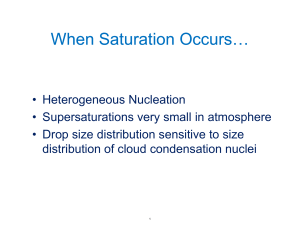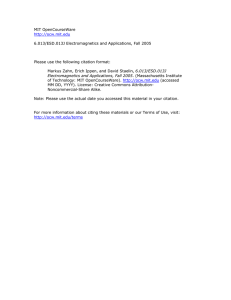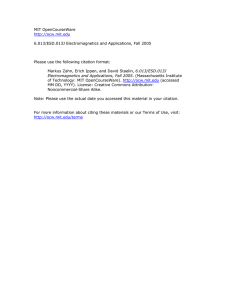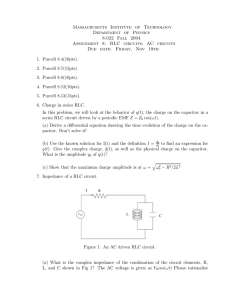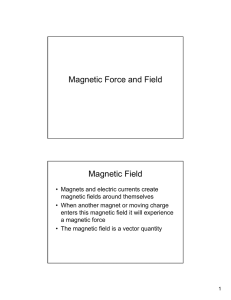MIT OpenCourseWare 6.013/ESD.013J Electromagnetics and Applications, Fall 2005
advertisement
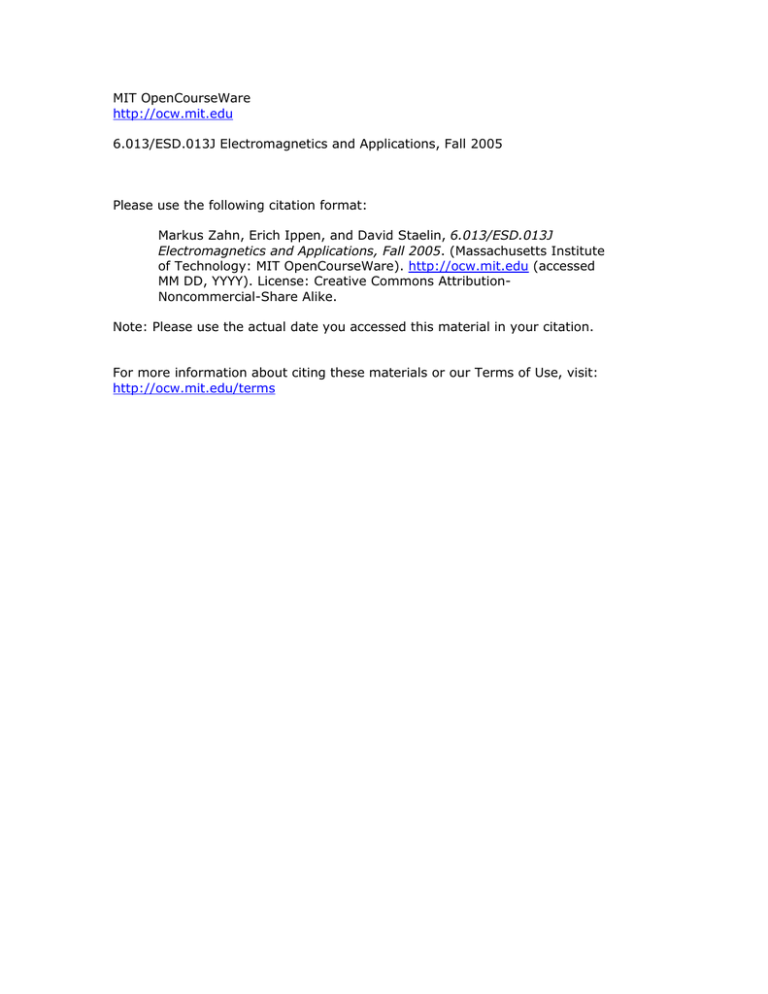
MIT OpenCourseWare http://ocw.mit.edu 6.013/ESD.013J Electromagnetics and Applications, Fall 2005 Please use the following citation format: Markus Zahn, Erich Ippen, and David Staelin, 6.013/ESD.013J Electromagnetics and Applications, Fall 2005. (Massachusetts Institute of Technology: MIT OpenCourseWare). http://ocw.mit.edu (accessed MM DD, YYYY). License: Creative Commons AttributionNoncommercial-Share Alike. Note: Please use the actual date you accessed this material in your citation. For more information about citing these materials or our Terms of Use, visit: http://ocw.mit.edu/terms Massachusetts Institute of Technology Department of Electrical Engineering and Computer Science 6.013 Electromagnetics and Applications Problem Set #1 SOLUTION Fall Term 2005 Problem 1.1 b. T= s Q1Q2 Mg = where sin θ = , 2 2l cos θ 4πε 0 s sin θ Q⎞ ⎛ ⎜ Q1 = Q2 = ⎟ 2⎠ ⎝ Mg4πε 0 ( 2l sin θ ) sin θ Q1Q2 Q 2 2 = 1 , sin θ tan θ = = Q1Q2 cos θ 16πε 0l 2 Mg 64πε 0l 2 Mg 2 c. i+ d ( −q ) dq , v =0⇒i = dt dt iR = R dq = − Rq0ω sin (ωt ) dt Problem 1.2 ∫ H ids = ∫ J i da , H ≈ b. Ampere’s integral law c. NΦ NBSb µ0 N 2 a = L= = = i i i 2 d. v=L Cb Sb λ di dv , i = C , v ( t = 0 ) = V ⇒ i = I sin (ωt ) , ω = dt dt At t = 0 , v ( t = 0 ) = V = LI ω ⇒ I = I =V e. Ni 2π a V C = V Lω L 1 LC 1 1 ; Note : LI 2 = CV 2 2 2 C ω 1 = sin (ωt ) , f = L 2π 2π LC 1 1 C Mv 2 = CV 2 ⇒ v = V M 2 2 1 2 1 CV = Mgh ⇒ h = CV 2 2 2Mg f. L = 0.1mH , I = 2000 A, v = 707m / s, h = 255m Problem 1.3 m qE0t 2 qE0 t 2 d 2 z , vz 0 t = z0 = 0 = qE ⇒ z = + v t + z = 0 0 z0 2m 2m dt 2 1 m d 2x x = 0 ⇒ x = v0t ⇒ t = 2 v0 dt z= qE0x 2 qE0 L2 , z x = L = h = ( ) 2mv0 2 2mv0 2 Problem 1.4 ( b. The Lorentz force law F =q E + v × B ) In the steady state F = 0 , so: E = −v × B ⎧⎪ v y iy ; postive charge carries v =⎨ , B = B0 iz ⎪⎩−v y iy ; negative charge carries ⎧⎪ v y B0 ix ; postive charge carries E=⎨ ⎪⎩−v y B0 ix ; negative charge carries c. VH = Φ ( x = d ) − Φ ( x = 0 ) = − ∫ Ex dx = ∫ Ex dx d 0 0 d ⎧ v y B0 d ; positive charge carriers VH = ⎨ ⎩−v y B0 d ; negative charge carriers d. As seen in part c, different polarity charge carriers have opposite polarity voltage, so the answer is an indubitable “Yes!”. Problem 1.5 a. As the line currents have infinite extent in the z direction the magnetic field has no dependence on the z coordinate. The magnetic field of a z-directed line current at the origin is: H = I 2π r iφ Convert cylindrical coordinates to Cartesian coordinates and move the line current to ( 0, d / 2 ) , the magnetic field is H= ⎛ ⎛ d⎞ ⎞ ⎜ − ⎜ y − 2 ⎟ ix + xiy ⎟ ⎛ ⎠ ⎠ d ⎞ ⎞⎝ ⎝ ⎛ 2π ⎜ x 2 + ⎜ y − ⎟ ⎟ ⎜ ⎝ 2 ⎠ ⎟⎠ ⎝ I 2 Moving the line current to H= ( 0, −d / 2 ) gives the magnetic field as ⎛ ⎛ d⎞ ⎞ ⎜ − ⎜ y + 2 ⎟ ix + xiy ⎟ ⎛ ⎠ ⎠ d ⎞ ⎞⎝ ⎝ ⎛ 2π ⎜ x 2 + ⎜ y + ⎟ ⎟ ⎜ ⎝ 2 ⎠ ⎟⎠ ⎝ I 2 2 The total magnetic field due to the two line currents is H total = ⎛ ⎛ d⎞ ⎞ I2 ⎛ ⎛ d⎞ ⎞ − y + ⎟ ix + xiy ⎟ ⎜ − ⎜ y− 2 ⎟ ix + xiy ⎟ + 2 ⎜ ⎜ 2⎠ ⎛ ⎛ ⎠ ⎠ ⎠ d ⎞ ⎞⎝ ⎝ d ⎞ ⎞⎝ ⎝ ⎛ ⎛ 2π ⎜ x 2 + ⎜ y + ⎟ ⎟ 2π ⎜ x 2 + ⎜y− ⎟ ⎟ ⎜ ⎟ ⎜ ⎟ 2⎠ ⎠ 2⎠ ⎠ ⎝ ⎝ ⎝ ⎝ I1 2 b. The force density on a line current (force per length) is F = I × B . At ( 0, d / 2 ) I 2 ix 2π d the magnetic field is: H = − F = I1 × µ0 H 2 = − µ0 I1 I 2 iy 2π d d d I2 2 2 . H x ( x, y = 0 ) = − 2 ⎛ 2 ⎛ d ⎞ ⎞ ⎛ 2 ⎛ d ⎞2 ⎞ 2π ⎜ x + ⎜ ⎟ ⎟ 2π ⎜ x + ⎜ ⎟ ⎟ ⎜ ⎜ ⎝ 2⎠ ⎟⎠ ⎝ 2 ⎠ ⎟⎠ ⎝ ⎝ I1 c. When I1 / I 2 = 1 , H x ( x, y = 0 ) = 0 H y ( x, y = 0 ) = I1 x I2 x , + 2 ⎛ 2 ⎛ d ⎞ ⎞ ⎛ 2 ⎛ d ⎞ 2 ⎞ 2π ⎜ x + ⎜ ⎟ ⎟ 2π ⎜ x + ⎜ ⎟ ⎟ ⎜ ⎜ ⎝ 2⎠ ⎟⎠ ⎝ 2 ⎠ ⎟⎠ ⎝ ⎝ When I1 / I 2 = −1 , H y ( x, y = 0 ) = 0 3
